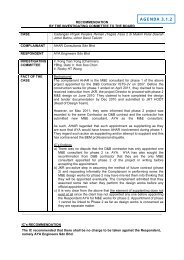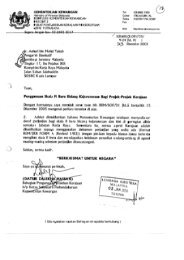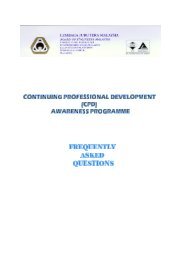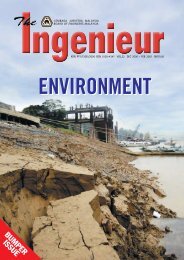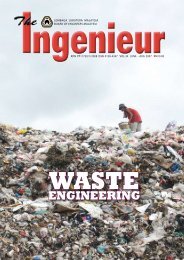Environmental Audit - Board of Engineers Malaysia
Environmental Audit - Board of Engineers Malaysia
Environmental Audit - Board of Engineers Malaysia
You also want an ePaper? Increase the reach of your titles
YUMPU automatically turns print PDFs into web optimized ePapers that Google loves.
cover feature<br />
<strong>Environmental</strong> <strong>Audit</strong> –<br />
A Proactive Tool For Pollution<br />
And Accident Prevention<br />
By Ir. Dr. Chong Hock Guan, CEO and Principal Consultant, GMP <strong>Environmental</strong> Consultants<br />
With many environmental<br />
accidents happening these<br />
days, we should be more<br />
proactive to find ways to prevent<br />
accidents. One <strong>of</strong> the ways is the<br />
effective use <strong>of</strong> environmental audits<br />
to regularly check an organisation’s<br />
environmental management and<br />
practices.<br />
Most engineers know the word<br />
“<strong>Environmental</strong> <strong>Audit</strong>”, but not many<br />
know its importance and benefits.<br />
Some have a misconception that<br />
environmental audit is a fault-finding<br />
exercise and a waste <strong>of</strong> time. Coupled<br />
with inexperienced auditors with poor<br />
understanding and application <strong>of</strong><br />
audit methodology, many<br />
environmental audits are conducted<br />
in a sub-standard manner, merely to<br />
satisfy the needs <strong>of</strong> certification or<br />
contractual requirements.<br />
Concepts Of <strong>Environmental</strong> <strong>Audit</strong><br />
Contrary to what most people<br />
believe, environmental audit is<br />
actually fact-finding work. A proper<br />
and systematic environmental audit<br />
will definitely yield benefits, and<br />
some <strong>of</strong> these benefits include:<br />
● Highlight positive efforts made in<br />
environmental performance<br />
● Identify potential environmental<br />
accidents<br />
● Initiate corrective and preventive<br />
action to avoid accidents and<br />
disasters<br />
● Ensure compliance with<br />
environmental legislation<br />
● Improve efficiency<br />
● Reduce wastage and improve cost<br />
savings<br />
● Enhance corporate image <strong>of</strong> the<br />
organisation<br />
● Increase confidence <strong>of</strong> customers<br />
in the processes and products<br />
● Educate and motivate the<br />
workforce<br />
● Demonstrate management<br />
commitment to environmental<br />
control<br />
● Improve the working environment<br />
– making the place safer and<br />
healthier<br />
● Encourage “self-regulation”- thus<br />
reduce the burden <strong>of</strong> enforcement<br />
So, what is “environmental audit’?<br />
<strong>Environmental</strong> audit can be<br />
defined as “a measure <strong>of</strong><br />
environmental risks, and an<br />
assessment <strong>of</strong> environmental<br />
opportunities”. The popular<br />
management concept – “What gets<br />
measured, gets done” – is well applied<br />
here. This means, audit should have<br />
measurement involved, and audit<br />
tools, which can measure<br />
quantitatively, will be able to measure<br />
the environmental performance<br />
effectively.<br />
Legal Requirements<br />
The <strong>Environmental</strong> Quality Act<br />
(EQA) 1974 <strong>of</strong> <strong>Malaysia</strong> specifies<br />
requirements on environmental audit;<br />
as contained in Section 33A<br />
<strong>Environmental</strong> <strong>Audit</strong> noted below:<br />
(1) The Director General may require<br />
the owner or occupier <strong>of</strong> any vehicle,<br />
ship or premises, irrespective <strong>of</strong><br />
whether the vehicle, ship or premises<br />
are prescribed under Section 18 or<br />
otherwise, to carry out environmental<br />
audit and to submit an audit report<br />
in the manner as may be prescribed<br />
by the Minister by regulations made<br />
under this Act.<br />
(2) For the purpose <strong>of</strong> carrying out<br />
an environmental audit and to submit<br />
BULETIN INGENIEUR 8<br />
a report there<strong>of</strong>, the owner or occupier<br />
so directed shall appoint qualified<br />
personnel who are registered under<br />
subsection (3).<br />
(3) For the purpose <strong>of</strong> this section,<br />
the Director General shall maintain a<br />
list <strong>of</strong> qualified personnel who may<br />
carry out any environmental audit<br />
and submit a report there<strong>of</strong>.<br />
In addition, Section 51 <strong>of</strong> the EQA<br />
1974 further states:<br />
(1) In addition to and not in<br />
derogation <strong>of</strong> any <strong>of</strong> the powers<br />
contained in any other provision <strong>of</strong><br />
this Act, the Minister after<br />
consultation with the Council may<br />
make regulations for or with respect<br />
to - (t) regulating environmental audit<br />
and the submission <strong>of</strong> an audit report<br />
and the appointment <strong>of</strong> qualified<br />
personnel to assist the Director<br />
General in carrying out an<br />
environmental audit <strong>of</strong> any vehicle,<br />
ship or premises, irrespective <strong>of</strong><br />
whether the vehicle, ship or premises<br />
are prescribed under section 18 or<br />
otherwise, and their manner <strong>of</strong><br />
operation, and prescribing the fees<br />
chargeable<br />
<strong>Environmental</strong> audit in the EQA<br />
1974 is defined as “a periodic,<br />
systematic, documented and objective<br />
evaluation’ to determine –<br />
(a) the compliance status to<br />
environmental regulatory<br />
requirements<br />
(b) the environmental management<br />
systems, and<br />
(c) the overall environmental risk <strong>of</strong><br />
the premises.<br />
It can be interpreted that the Act<br />
requires three types <strong>of</strong> the<br />
environmental audit to be done<br />
notably:
● Compliance <strong>Audit</strong><br />
● <strong>Environmental</strong><br />
Management Systems<br />
<strong>Audit</strong><br />
● Risk <strong>Audit</strong><br />
As noted below, these are<br />
three <strong>of</strong> the many other<br />
types <strong>of</strong> environmental<br />
audit.<br />
Types Of<br />
<strong>Environmental</strong> <strong>Audit</strong><br />
The main types <strong>of</strong><br />
environmental audit can<br />
be categorised as:<br />
1. Compliance <strong>Audit</strong> –<br />
mainly to check on<br />
compliance with the legal<br />
or corporate requirements<br />
2. <strong>Environmental</strong><br />
Management Systems<br />
<strong>Audit</strong> – The International<br />
Standard, ISO 14001<br />
<strong>Environmental</strong><br />
Management Systems-<br />
Specification with<br />
guidance for use specifies<br />
clearly such a<br />
requirement. This audit<br />
checks the whole<br />
management system with<br />
regards to the<br />
requirements <strong>of</strong> ISO<br />
14001 Standard. Figure<br />
1 shows the ISO 14001 EMS model.<br />
3. Risk <strong>Audit</strong> – This type <strong>of</strong> audit<br />
evaluates the level <strong>of</strong> environmental<br />
risks with regards to the operation and<br />
activities in such organisation.<br />
4. Due Diligence <strong>Audit</strong> – This is<br />
used by organisations or banks to<br />
evaluate environmental conditions<br />
when dealing with merging,<br />
acquisition or divestment <strong>of</strong><br />
properties.<br />
5. <strong>Environmental</strong> Impairment<br />
Liability <strong>Audit</strong> – an essential prerequisite<br />
for organisations to obtain<br />
insurance to cover the liability<br />
resulting from environmental<br />
pollution and impact.<br />
6. <strong>Environmental</strong> Marketing <strong>Audit</strong><br />
– such an audit is used by<br />
organisations to check that their<br />
products are in conformance with<br />
consumer and legislative<br />
requirements.<br />
7. Energy <strong>Audit</strong> – Since energy<br />
production involves natural resources,<br />
this type <strong>of</strong> audit covers the collection,<br />
analysis and interpretation <strong>of</strong> energy<br />
audit. The results are cost savings and<br />
efficient use <strong>of</strong> energy.<br />
8. Certification <strong>Audit</strong> – This<br />
involves assessment against an agreed<br />
standard prior to issuance <strong>of</strong> certificate.<br />
9. <strong>Environmental</strong> Performance<br />
<strong>Audit</strong> – checks on environmental<br />
performance, including continual<br />
improvement in reducing<br />
environmental pollution.<br />
10. <strong>Audit</strong> on Contractors and<br />
Suppliers – examines the<br />
environmental activities <strong>of</strong> its<br />
contractors and suppliers, in particular,<br />
in reference to their compliance to<br />
environmental legislation and<br />
standards.<br />
11. Product <strong>Audit</strong> – This usually<br />
checks the product life-cycle, from<br />
BULETIN INGENIEUR 9<br />
conception to final disposal, to ensure<br />
all processes and raw materials used<br />
are in-line with environmental<br />
requirements.<br />
12. Cleaner Production <strong>Audit</strong> – Also<br />
called Waste Minimization <strong>Audit</strong>. This<br />
audit finds the processes involved in<br />
reducing and eliminating the use <strong>of</strong><br />
toxic chemicals, which aims to result<br />
in less pollution and toxic wastes<br />
produced.<br />
As there are many types <strong>of</strong><br />
environmental audit, every<br />
organisation has to be clear on and<br />
specific which type <strong>of</strong> environmental<br />
audit it needs.<br />
Systematic <strong>Environmental</strong><br />
<strong>Audit</strong> Methodology<br />
A systematic environmental audit<br />
consists <strong>of</strong> three main stages:<br />
cover feature
cover feature<br />
1. Pre-<strong>Audit</strong><br />
Pre-audit deals with preparations<br />
prior to the audit on-site. The work<br />
include:<br />
● communicating with the site<br />
personnel on the audit<br />
● obtaining background information<br />
about the site<br />
● defining the scope and intent <strong>of</strong><br />
the audit<br />
● determining the type <strong>of</strong> audit<br />
● selecting audit team members<br />
● preparing the necessary equipment<br />
– audit checklists, personal<br />
protective equipment and other<br />
audit tools<br />
● making preparations on logistic,<br />
accommodation and<br />
transportation if needed, and<br />
● sending a letter <strong>of</strong> notification to<br />
the site to confirm the audit onsite<br />
2. On-Site <strong>Audit</strong><br />
This is the main bulk <strong>of</strong> the<br />
audit, and is done in the ‘auditee’.<br />
<strong>Audit</strong>ee is defined as the<br />
organisation being audited. This<br />
Verification<br />
Interviews<br />
GMP ENVIRONMENTAL<br />
CONSULTANTS<br />
phase comprises five events in<br />
sequence, they are:<br />
(i) Opening meeting – This is the<br />
first formal event at the site, and<br />
should be attended by audit team<br />
and the management <strong>of</strong> the auditee.<br />
Usually the top management will<br />
address the audience first, and the<br />
audit team leader will then inform<br />
the management on the agenda and<br />
the methodology <strong>of</strong> the audit.<br />
(ii) Familiarization tour – The audit<br />
team members are accompanied by<br />
key personnel <strong>of</strong> the auditee to visit<br />
the site briefly in order to be familiar<br />
with the nature <strong>of</strong> operations and<br />
the environmental concerns. It<br />
should be noted that this is not site<br />
inspection. This event is not needed<br />
if the audit team members are<br />
familiar with the site.<br />
(iii) Interviewing the knowledgeable<br />
persons – This is the essence <strong>of</strong> the<br />
on-site audit, whereby key<br />
personnel are interviewed to obtain<br />
Interviewing<br />
Knowledgeable Persons<br />
Facts<br />
Verification <strong>of</strong> Responses<br />
Document<br />
Review<br />
<strong>Audit</strong><br />
Findings<br />
BULETIN INGENIEUR 10<br />
facts in response to the audit<br />
questions. Figure 2 shows the<br />
importance sequence <strong>of</strong> events for<br />
this on-site audit technique.<br />
(iv) Verification – The facts obtained<br />
from the knowledgeable persons are<br />
verified. There are three techniques<br />
<strong>of</strong> verification:<br />
● Document review – this exercise<br />
examines the manual, procedures,<br />
work instructions, records and<br />
supporting documents<br />
● Verification interviews –<br />
involves interviewing employees<br />
randomly to check the<br />
implementation <strong>of</strong> systems in<br />
place.<br />
● Site Inspection – all physical<br />
installations at the site are<br />
checked against the standards<br />
and good environmental<br />
practices.<br />
A combination <strong>of</strong> any three<br />
verification techniques can be used,<br />
with the main intent <strong>of</strong> confirming<br />
evidence <strong>of</strong> the facts obtained.<br />
Site<br />
Inspection
(v) Closing Meeting – <strong>Audit</strong> findings<br />
and conclusions are presented by the<br />
audit team leader to highlight<br />
“Noteworthy Efforts” (conformities)<br />
and “Areas for Improvement” (nonconformities).<br />
Recommendations<br />
should be provided by the audit team,<br />
though they are not binding.<br />
3. Post –<strong>Audit</strong><br />
This is mainly report writing and<br />
follow up after the submission <strong>of</strong><br />
report. The report is confidential, and<br />
should be factual with key findings<br />
from the audit, notably with sections<br />
on Noteworthy Efforts and Areas for<br />
Improvement. Recommendations for<br />
improvement should be included,<br />
unless specifically requested to be<br />
excluded by the client.<br />
A good audit report should<br />
contain the following sections:<br />
● Cover Letter<br />
● Executive Summary and<br />
Score Sheet<br />
● Working Copy<br />
● Findings from Site Inspection<br />
● Summary <strong>of</strong> Verification<br />
Interviews<br />
● Conclusion and Suggestions for<br />
Action<br />
Depending on the contractual<br />
requirements, usually two copies <strong>of</strong><br />
the reports are submitted to the client,<br />
with a copy extended to the auditee.<br />
The client may pose questions after<br />
reading the audit report, and the audit<br />
team leader must be prepared to meet<br />
the client and the auditee’s<br />
representatives to make presentations<br />
<strong>of</strong> the findings and to answer specific<br />
questions.<br />
<strong>Audit</strong> Tool<br />
A good audit tool consists <strong>of</strong><br />
checklists that are accurate and<br />
reliable so that competent auditors<br />
using the tool and working<br />
independently would reach similar<br />
audit findings from evaluating the<br />
same audit evidence. A good audit<br />
tool should preferably have a<br />
qualitative or quantitative<br />
measurement <strong>of</strong> the audit results. GMP<br />
ISO 14001 <strong>Audit</strong> Scheme® is one such<br />
tool which has been widely used in<br />
industries for measuring quantitatively<br />
the audit results <strong>of</strong> environmental<br />
management systems (EMS).<br />
Figure 3 shows that using the<br />
GMP ISO 14001 <strong>Audit</strong> Scheme®, the<br />
overall audit results can be<br />
measured quantitatively against the<br />
EMS Standard from a scale <strong>of</strong> 0-<br />
100%. Figure 4 shows the detail<br />
results for each component <strong>of</strong> ISO<br />
14001 in achieving the overall<br />
results in Figure 3.<br />
Responsibilities Of <strong>Audit</strong>ors<br />
<strong>Environmental</strong> auditors, whether<br />
internal or external auditors, are<br />
pr<strong>of</strong>essionals. As such, proper codes<br />
<strong>of</strong> ethic or principles should be<br />
followed.<br />
ISO 19011: 2002 Guidelines for<br />
Quality or <strong>Environmental</strong><br />
Management Systems <strong>Audit</strong>ing states<br />
clearly the principles for auditing as<br />
noted below:<br />
● Ethical conduct: The foundation<br />
<strong>of</strong> pr<strong>of</strong>essionalism. Trust, integrity,<br />
confidentiality and discretion are<br />
essential to auditing.<br />
● Fair presentation: the obligation<br />
to report truthfully and accurately.<br />
<strong>Audit</strong> findings and conclusions<br />
should be accurate substantiated<br />
with facts and evidence.<br />
● Due pr<strong>of</strong>essional care: the<br />
application <strong>of</strong> diligence and<br />
judgment in auditing.<br />
● Independence: auditors should be<br />
unbiased and free from conflict <strong>of</strong><br />
interests.<br />
Figure 3 - <strong>Audit</strong> Score using GMP ISO 14001 <strong>Audit</strong> Scheme ®<br />
100%<br />
22.7%<br />
Baseline EMS <strong>Audit</strong> Result for AAA Sdn Bhd<br />
BULETIN INGENIEUR 11<br />
EMS Standard<br />
Areas for<br />
Improvement<br />
Noteworthy<br />
Efforts<br />
● Evidence-based approach: the<br />
rationale method for reaching<br />
reliable audit conclusions in a<br />
systematic audit process.<br />
<strong>Audit</strong> team members should be<br />
competent with the following criteria<br />
(based on ISO 19011:2002 for EMS<br />
<strong>Audit</strong>ors):<br />
(a) Entry qualification – the<br />
minimum entry qualification is<br />
secondary education, though a<br />
university/college qualification is<br />
preferred.<br />
(b) Qualified in specific knowledge<br />
and skills – these can be achieved<br />
via university education or<br />
external training. For an<br />
environmental management<br />
systems auditor, the training<br />
syllabus should include:<br />
● <strong>Audit</strong> principles and<br />
methodology<br />
● Management systems - ISO<br />
14001 EMS Standard<br />
● <strong>Environmental</strong> engineering<br />
and technology<br />
● Organisation’s operation and<br />
general business process<br />
● <strong>Environmental</strong> law<br />
At least 40 hours <strong>of</strong> training is<br />
needed for the above courses.<br />
(c) <strong>Environmental</strong> related work<br />
experience – at least two out <strong>of</strong><br />
a total <strong>of</strong> five years for those with<br />
5-7 July 2004<br />
cover feature
cover feature<br />
Figure 4 - Graph on Details <strong>of</strong> <strong>Audit</strong> Score<br />
PERFECT SCORE<br />
4.1<br />
ISO 14001 CLAUSE<br />
4.2<br />
4.3.1<br />
4.3.2<br />
4.3.3<br />
4.3.4<br />
4.4.1<br />
4.4.2<br />
4.4.3<br />
4.4.4<br />
4.4.5<br />
4.4.6<br />
4.4.7<br />
4.5.1<br />
4.5.2<br />
4.5.3<br />
4.5.4<br />
4.6<br />
AVERAGE<br />
GMP ISO 14001 AUDIT SCHEME<br />
GMP ISO 14001 AUDIT SCHEME - GRAPHICAL PRESENTATION<br />
<strong>Audit</strong>ed Site : AAA Sdn Bhd Date : 5-7 July 2004<br />
BASELINE EMS ISO 14001 AUDI T<br />
0.0%<br />
0.0%`<br />
0.0%<br />
0.0%<br />
0.0%<br />
0.0%<br />
14.3%<br />
16.7%<br />
20.0%<br />
25.0%<br />
20.0%<br />
22.7%<br />
33.3%<br />
33.3%<br />
33.3%<br />
37.5%<br />
42.9%<br />
50.0%<br />
0 10 20 30 40 50 60 70 80 90 100<br />
SCORE PERCENTAGE<br />
Infancy Developing Maturing Advanced Desired<br />
secondary education, and at least<br />
two out <strong>of</strong> a total <strong>of</strong> four years<br />
for those with university/college<br />
qualification.<br />
(d) On-the job training and<br />
experience – minimum four<br />
complete audits for a total <strong>of</strong> at<br />
least <strong>of</strong> 20 days.<br />
In <strong>Malaysia</strong>, the Society <strong>of</strong><br />
<strong>Environmental</strong> <strong>Audit</strong>ors <strong>Malaysia</strong><br />
(SEAM) was set up in 1998 to gather<br />
the environmental auditors in<br />
<strong>Malaysia</strong> and to provide them with<br />
information networks regarding the<br />
development <strong>of</strong> environmental audit<br />
and environmental management.<br />
Conclusion And The Way Forward<br />
While there are many benefits<br />
and need for environmental audit,<br />
challenges still exists which must be<br />
resolved. Some factors that can be<br />
considered to ensure success <strong>of</strong><br />
environmental audit in <strong>Malaysia</strong><br />
are:<br />
● Enforce the use <strong>of</strong> environmental<br />
audit through <strong>Environmental</strong><br />
<strong>Audit</strong> Regulations by the<br />
Department <strong>of</strong> Environment.<br />
Enforcement imposed by the<br />
Government will increase the<br />
practice <strong>of</strong> environmental audit.<br />
● Increase awareness on the<br />
importance and benefits <strong>of</strong><br />
environmental audit, through<br />
talks, training, campaigns,<br />
promotions and bulletins.<br />
● Recognise and promote<br />
environmental auditors as<br />
important pr<strong>of</strong>essionals in the<br />
development <strong>of</strong> the nation.<br />
● Provide incentives to<br />
organisations practicing good<br />
environmental audits – this can be<br />
done through awards and tax<br />
incentives.<br />
● Train more environmental<br />
auditors to encourage the proper<br />
application <strong>of</strong> environmental<br />
audit.<br />
There are tremendous<br />
opportunities for environmental audit<br />
BULETIN INGENIEUR 12<br />
GMP <strong>Environmental</strong> Consultants<br />
100%<br />
to grow in <strong>Malaysia</strong>. Both the public<br />
and private sectors have respective<br />
roles to play to ensure the success <strong>of</strong><br />
environmental audit in <strong>Malaysia</strong>.<br />
REFERENCES<br />
1. Chong H.G., December 1999,<br />
<strong>Environmental</strong> <strong>Audit</strong> from the<br />
Perspective <strong>of</strong> A Consultant, Bengkel<br />
<strong>Audit</strong> Alam Sekitar, Department <strong>of</strong><br />
Environment, <strong>Malaysia</strong>.<br />
2. Chong H.G., March 2004,<br />
<strong>Environmental</strong> <strong>Audit</strong> Training<br />
Manual (Edition 9), GMP<br />
<strong>Environmental</strong> Consultants,<br />
<strong>Malaysia</strong>.<br />
3. International Organization for<br />
Standardization, 1996, ISO 14001:<br />
<strong>Environmental</strong> Management Systems<br />
– Specification with Guidance for<br />
Use, Switzerland.<br />
4. International Organization for<br />
Standardization, 2002, ISO 1901:<br />
Guidelines for quality and/or<br />
environmental management systems<br />
auditing, Switzerland. BEM



